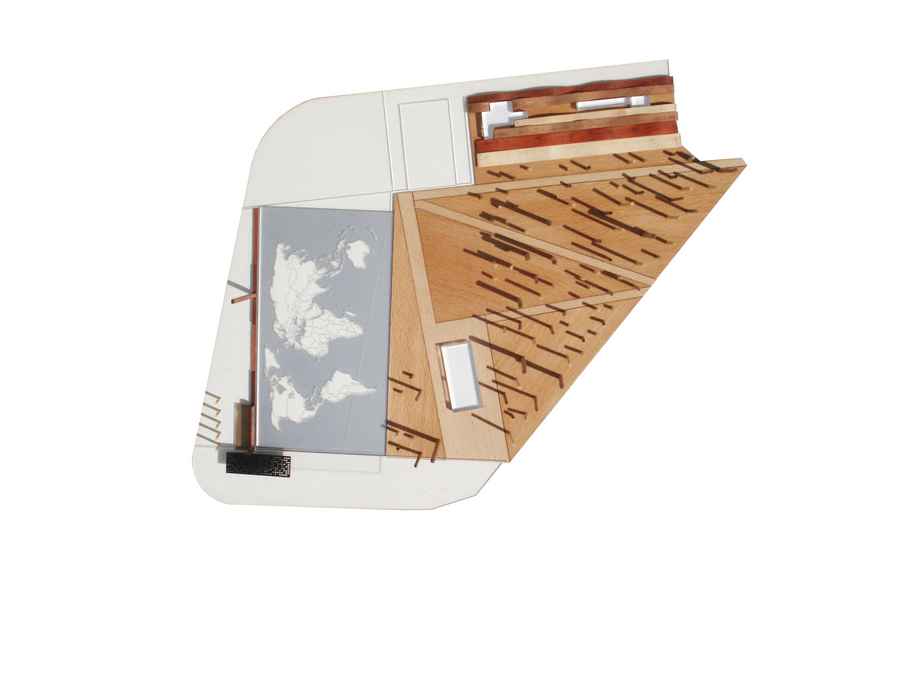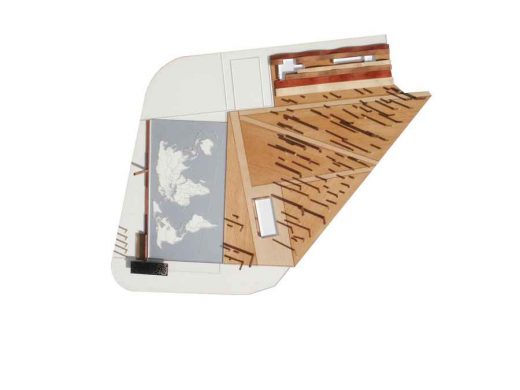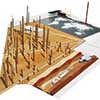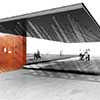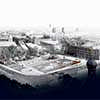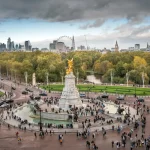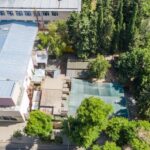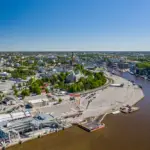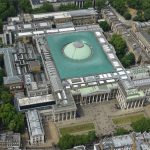Leipzig Architecture Competition, Saxony monument design contest news, German memorial
Leipzig Monument to Freedom and Unity Competition
German Architectural Contest in Saxony – buildings in southeast Germany, Europe
Entry by Mateo Arquitectura for Leipzig’s Monument to Freedom and Unity
Leipzig Monument to Freedom & Unity
Author: Josep Lluís Mateo
Landscape designer: Manel Colominas
Artist (map): Matt Mullican
23 Oct 2012
Leipzig Monument to Freedom and Unity Competition Entry
The purpose of the Leipzig Freedom and Unity Memorial is to commemorate the “Peaceful Revolution” of 1989 that made Leipzig a decisive place for the fall of the Berlin wall with the construction of this monument.
Project description written by Josep Lluís Mateo for the competition:
Surface versus mass (horizontal versus vertical)
There is an axis that runs through our place and ends at the monument to the Battle of Leipzig. Two monuments to remembering: an old battle represented by a kind of mountainous mass, and a peaceful uprising, the movement of people, lights in the night that draw out a flat figure of changing pixels.
The memory we aim to commemorate is that of a peaceful mass change, with no hierarchies, that we see in historic photos as points of light, changing like a surging sea.
Formally and conceptually, we decided that our intervention here should address surface rather than volume; it should be horizontal rather than vertical. As opposed to the mountain of the Völkerschlachtdenkmal (Battle of the Nations monument), we were the sea that steadily wears down the hard rock and turns it into sand.
The urban space
We stand at the entrance to the historic city, in a vast empty space that will be partially developed.
Thinking about the intervention that is prompted by memory in relation to the future urban space also played a vital role in our proposal.
Our idea was to consider the entire open area as urban space shaped by the narrative logic of the event we are celebrating.
On the surface, the place is informed by the north-south axis of movements constructed by the new underground railway inside—a place of movement, but also a popular and domestic space to be.
The place is divided into three parts:
A The forest of memory
It establishes contact with the new built interventions in the south-east. An earthen floor, a place for families with children. Its design is an allegory of the history we commemorate: a variety of plant species interpret the different textures expressed by the demonstrations of the time. The succession of the plants, with their different flowering times, marks the progressive sequence of densities of the history being recalled here.
B The floor of the masses
A large area paved with small pieces of stone provides the base for the great meeting place for the masses.
The paving forms the world, remembering unity at a larger scale.
Set into the paving are lights, a drinking fountain, other memories (historical traces).
It is delimited by two broken walls: to the left, near Petersteinweg, are part of the pavilion of remembering, benches, the support that is the great vertical pole shining light into the world at night.
To the right, the wall is simply a difference in levels, a seat. The plain has overtaken the wall.
The space is designed to be the venue for further demonstrations, an ice rink, a Christmas market, a rock concert, for example.
C The pavilion of remembering
On the corner of Petersteinweg and Windmühlenstraße, a small built irregularity provides a more explicit recollection of history.
This object has three parts:
1. Red wall with holes in it A concrete wall with metal shavings as sand gradually reddens over time.
The wall breaks up; instead of separating, it unites. The words “Wir sind das Volk” generate windows in the wall.
2.The golden pool of wishes
At its base, the red wall is reflected in a small pool. The pool is gold (at least, the bottom looks gold). You can imagine coins being thrown into it, like in other places, to make wishes come true.
3.The dark sky: the filter of light
A small roof resting on the wall, perpendicular to it, filters the sunlight, breaking it down into rays.
These rays fall on the ground, thick stone slabs engraved with the words of that time. Words of that time and of ours.
25 Nov 2011
Leipzig Monument to Freedom and Unity : Competition
Leipzig’s Monument to Freedom and Unity : Competition to be conducted for the Monument to the Peaceful Revolution 1989
On 9th October 2011, the 22nd anniversary of the Peaceful Revolution of 1989, the City of Leipzig will hold an open application process for a Monument to Freedom and Unity.
In 2008, the German Bundestag assigned the Federal Government to erect a monument to freedom and unity not only in Berlin, but also in the City of Leipzig.
Monday demonstration, 27.11.1989:
photo © LTS-Kühne
The protest march of 70.000 people in Leipzig on 9th October 1989 triggered the breakthrough of the Peaceful Revolution in the GDR and cleared the road to German unity. The Leipzig Monument to Freedom and Unity is to be a national monument which transcends over the City through its location, stature and significance. It is to address a wide democratic public and above all, future generations through its political and artistic demands.
In May 2011, Leipzig City Council designated Wilhelm-Leuschner-Platz as the location for the monument, directly on the Leipziger Ring, where the demonstration took place in 1989. The Leipzig Monument to Freedom and Unity is to be inaugurated on 9th October 2014 in celebration of the 25th anniversary of the Peaceful Revolution in what will be the newly named ´Platz der Friedlichen Revolution`.
Aerial view: Wilhelm-Leuschner-Platz:
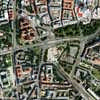
photo © ATKIS® -DOP, © GeoSN 2009
“The 9th October 1989 moves us all”, said Burkhard Jung, Lord Mayor of Leipzig. “On that day in Leipzig world history was made. The non-violent march of 70.000 around the Promenadenring marked the break through. The Peaceful Revolution strengthened the self-deliverance of Eastern Europe and established the unity of Germany”.
Minister of Culture Bernd Neumann said: “The Leipzig Monument is to remind us of the Peaceful Revolution and of the civil courage shown by the people of East Germany. The non-violent protest of tens of thousands in Leipzig on 9thOctober brought about the breakthrough for political change in the GDR. The courage shown by the citizens of Leipzig and other cities, brought about the fall of the SED regime. That we now live in freedom and a unified Germany is thanks to those citizens. The monument will be erected here in Leipzig it being one of the most important areas of the revolution. It is however to stand as a symbol for the complete Peaceful Revolution in the GDR”.
The symbolic value is one of the main objectives for Saxony. “As German history teaches us, Peace and freedom should not be taken for granted. Courageous men and women overthrew a communist dictatorship in Autumn 1989. They paved the way to democracy in a unified Germany. The Monument to Freedom and Unity will be there to permanently remind us of that”, said Dr. Johannes Beermann, the Head of State Chancellery in Saxony.
Leipzig 1989: child on his father’s shoulder:
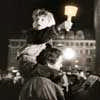
image © LTM/Eckstein
Artists, architects and landscape architects from all over the world are invited to submit an application by 16th December 2011 at the latest. 40 applicants/teams will then be chosen to take part in the restricted competition according to RPW 2008 (guide lines for planning competitions). The selection of participants will be carried out by the client of Leipzig in consultation with a selection committee consisting of external experts.
The financial framework for the whole project is 6.5 million euro, of which 5 million euro will be from the Government and 1.5 million euro from the Free State of Saxony. A gross amount of 175.000 euro will be available for the competition.
Further information: www.leipzig.de/monument
Lars Loebner, City Planning Office
Tel. ++49 341 123 4834 E-Mail: lfed@leipzig.de
Location: Leipzig, Saxony, Southeastern Germany.
Leipzig Developments
Contemporary Saxony Region Architectural Projects
Leipzig Architecture Designs – chronological list
St. Trinitatis Church in Leipzig
Leipzig Buildings
University of Leipzig Building
Erick van Egeraat
Neue Messe Central Hall Leipzig
Redevelopment by Ian Ritchie Architects
Bayerischer Bahnhof Leipzig
Christian August Eduard Pötzsch
Comments / photos for the Leipzig Monument to Freedom and Unity Competition page welcome
Website: Visit Leipzig

